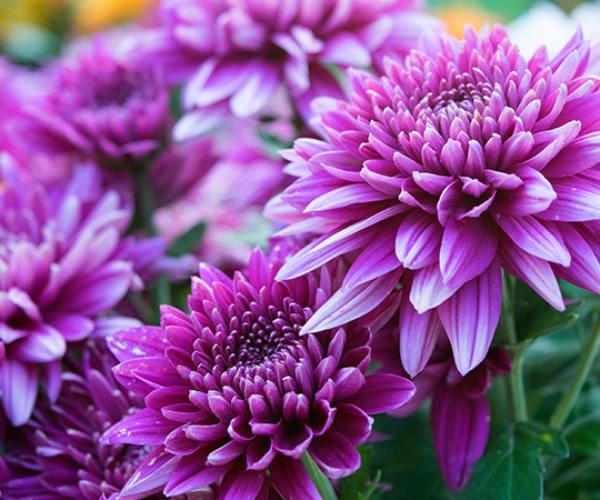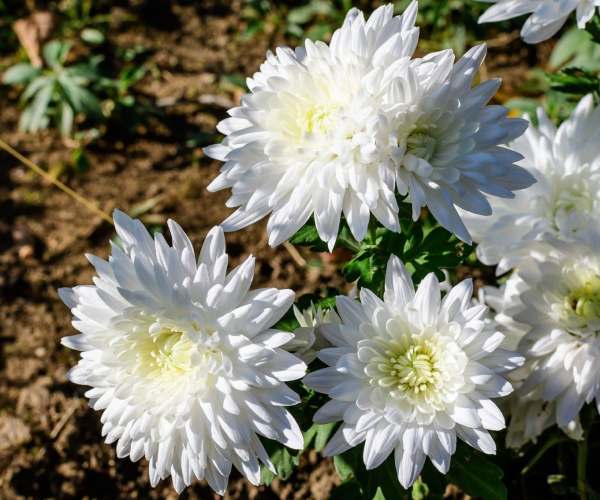What are Chrysanthemums?
Chrysanthemums belong to the Compositae family and are available in a wide variety of amazing colors, shapes, and sizes. These beautiful plants were first cultivated in China over 600 years ago. This kind of daisy was primarily grown as a herb associated with the power of life. These plants bear flowers ranging from dazzling whites to deep bronzes and they have full, dark green leaves.
While it seems that the Chrysanthemum flowers have many petals, each petal is a small floret. There are two types of florets: ray and disc florets. Ray florets are traditionally the petals while the disc florets create the beautiful buttons. It is when the florets are all clustered together that they give us what we know as a mum bloom.
Also, Read Planting Smarter: 10 Ways to Save Money When Shopping for Plants!
Types of Chrysanthemums
The National Chrysanthemum Society has classified the system in 13 different mums by flower shape.
-
Anemone
These daisy-look-like flowers consist of long, tubular florets clustered around a tight-button center. They form a 4-inch bloom in single or multiple colors. Popular varieties are Dorothy Mechum, Purple Light, and Angel.
-
Decorative
These mums are florists’ favorites which they use in floral arrangements. The 5-inch plus blooms give a flat appearance as the florets slowly get longer from the center. Fireflash, Coral Charm, and Honeyglow are some popular varieties.
-
Irregular Incurve
These blooms feature florets curving inwards. Irregular mums feature large blooms which can grow up to 6 to 8 inches. The florets curve in and cover the system of the flower. Some florets at the bottom of the bloom add an attractive fringe to the stem. Luxor, Blushing Bride, and River City are some of the popular varieties of this plant.
-
Intermediate Incurve
The florets of the intermediate incurve do not cover the center of the bloom. While shorter florets curve inwards, the less-compact bloom of an intermediate incurve only reaches a maximum of 6 inches. Popular varieties include Apricot Alexis, Candid, and Pat Lawson.
-
Regular incurve
Regular incurve chrysanthemum blossoms are tight, smooth globes of inwardly curving florets. Each bloom is between 4 to 6 inches in diameter. Popular varieties include: Gillette, Moira, and Heather James
-
Pompom
Pompoms resemble regular incurves and their mums grow only 1 to 4 inches. The tight blooms are common in floral arrangements. Popular varieties include Rocky, Yoko Ono, and Lavender Pixie.
-
Quilled
These eye-catching quilled chrysanthemums feature long, tubular florets that open to a spoon shape or a slight downward curve at the end. Their spiky appearance often mimics other types of mums. Seatons Toffee, Mammoth Yellow Quill, and Muted Sunshine are some of its popular varieties.
-
Single and Semi-double
These daisy-like mums feature one or two rounds of ray florets around a compact center. Their total plant size is between 1 to 3 feet, making them super ideal for small spaces and borders. Popular varieties are Rage, Icy Island, and Crimson Glory.
-
Spider
Spider mums are popular for their long, spiky florets of single or multiple colors. The tubular florets look like spider legs and can go in all directions. The delicate and exotic appearance creates a focal bloom in your garden. Popular varieties include Evening Glow, Symphony, and Western Voodoo.
-
Spoon
Spoon mums have a button center surrounded by ray florets featuring a spoon shape at the tip. People often mistake them for single chrysanthemums, but the actual difference is in the slight curve. Popular varieties include Kimie, Fantasy, and Redwing.
-
Reflex
The bloom of a reflex mum is a little flat with florets that curve downward. The crossing of the florets produces a stunning feather-like appearance. Popular varieties include: White City, Champion, and Apricot.
-
Thistle
The thistle bloom, also known as the bush bloom, often has a multi-colored bloom. The long, thin florets twist to rise or fall backward towards the stem. Thistle blooms have a unique look to them. Popular varieties include Cindy, Cisco, and Orange Spray.
-
Unclassified
With so many chrysanthemum varieties, many chrysanthemum blooms feature characteristics that place them in more than one category. Unclassified mums exhibit a wide range of colors and sizes. Popular varieties include Lone Star, Lili Gallon, and Pacificum.
Also, Read Yellow Leaves on Your Indoor Plants? Understand the Causes and Solutions
How to plant Chrysanthemums?
You might be thinking about how to grow Chrysanthemums to give your garden a beautiful look as quickly as possible. First, you have to understand how to plant it in the right manner so that chrysanthemums reward you with full, beautiful plants loaded with blooms.
-
When is the right time to plant Chrysanthemums?
Planting chrysanthemums in the spring is the ideal time as it gives the perennial plant time to establish and adapt to its new garden home. You’ll easily find mums in garden centers and nurseries in both fall and spring. However, planning beforehand is key to successful planting. It’s tempting to buy those huge beautiful fall mums you see during the autumn season, but in terms of longevity, the smaller spring mums are actually a better investment. The root system becomes stronger throughout the summer and fall, which increases a plant’s ability to survive the cold and the harsh winter. Planting in the spring will also result in a bigger size bloom in the coming season. Although some fall mums can survive winter if planted immediately, it is much better with spring-planted mums.

2. How hardy are Chrysanthemums?
The chrysanthemums you purchase in garden centers are normally called “hardy mums” for a specific reason. The majority of mum varieties are winter hardy in Zones 5 through 9. Some varieties, such as Mammoth Daisy, are hardy down to Zone 3. When shopping for mums, be sure to check the label to make sure you’re purchasing hardy garden varieties appropriate for your planting zone. Local nurseries and garden centers will most often feature varieties that are staples to local areas. Don’t purchase from floral shops – their mums are different, less hardy floral varieties.
3. What is the best soil for mums?
Chrysanthemums can survive and grow in most soils, but they do best in well-draining soil with consistent moisture. Growing mums in hard, dry soil prevents the roots from becoming well established, while wet, boggy soil drowns the roots. Finding the middle ground is the best option. If you’ve planted other perennials, then you’re already sure how to plant chrysanthemum. To create good soil for your mums, work your soil to a depth of 8 to 12 inches. Mix in 2 to 4 inches of organic material, such as compost or peat moss. The perfect soil texture can be tested by taking a handful and squeezing. When you open your hand, the soil shouldn’t clump or quickly fall apart. It should easily crumble.
4. How much sunlight is necessary for mums?
Chrysanthemums are sun-adoring plants. Although they technically require only 6 hours of sunlight each day, the more light they receive, the better it is for their growth, bloom, and hardiness. Slight shade in hot, summer afternoons is favorable in warmer gardening zones to prevent scorching. Mums bloom due to their photoperiodic nature. When the plant senses a change in the length of darkness in late summer, it begins to set buds. Planting near artificial lights, such as security lights or porch lights, can affect the bloom time of your mums.
5. Is spacing necessary?
It can be quite a task to plant mums closely together. Smaller, spring mums don’t seem to fill out a garden space as well. However, know that by fall, most properly planted mums will reach up to 3 feet in height and width. Like many perennials, mums will often grow each year. Even if your flower bed looks a bit bare when you first plant your mums, in time it will fill in. Spacing mums properly is important for plant health. Plants that are too crowded lack nutrients, have root system issues, attract pests, and suffer from disease. Following the plant spacing directions for your chrysanthemum variety increases the health of your garden and protects your investment of time and money.
How to care for Chrysanthemums
Mums are generally called low-maintenance plants. Despite that, it is important to care for these lovely plants properly simply requires basic gardening techniques. With just a little special chrysanthemum care, your garden will be filled with a multitude of beautiful blooms.
-
How often should we water mums?
Mums need good moisture for the best growth. Regular watering throughout the spring, summer, and fall is necessary. The ideal watering method for mums is to apply moisture directly to the base of the plants. This prevents moisture from becoming trapped in the thick foliage.

2. Are fertilizers needed for mums?
All plants require nutrients and fertilizing mums provides them an extra boost of the right nutrients for the best growth of the mums. Consistent applications of quality fertilizers will help your mums grow larger and produce more blooms. Choose a balanced, water-soluble fertilizer for monthly application from early spring through July. If you plant fall mums, wait to begin their fertilization until the spring. Fall fertilization can reduce the hardiness of chrysanthemums to survive cold winters.
